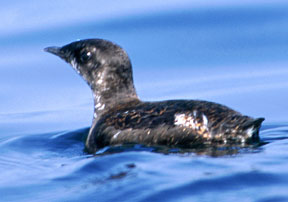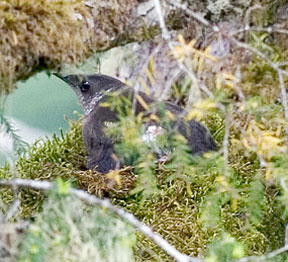Species of Concern Profile: Marbled Murrelet—September 2006
In 1778, Captain Cook’s naturalist collected some specimens of the Marbled Murrelet on one of the early European explorations of the West Coast of the Americas, but it took nearly two centuries for scientists to figure out where these birds were nesting. It wasn’t until 1974, when a tree climber nearly stepped on a murrelet chick high up on the moss-covered limb of an ancient conifer, that the mystery was solved. With a high-pitched, gull-like series of squeals, these old-growth forest seabirds are also known as “fog larks.” But a vocal repertoire doesn’t make them easy to find; even today fewer than 900 nests have ever been discovered.
Though Marbled Murrelets are commonly seen loafing and feeding in the near-shore marine environment from Alaska to California, COASSTers have only found 19 of them on the beach since surveys began in 1999. More than half of the Marbled Murrelet finds have been on the North Coast of Washington, with nine from a single beach (Hobuck, of course!). A few have made their way inshore, with two showing up in the Strait of Juan de Fuca and two in Puget Sound. The South Coast of Washington and Oregon North have also seen a couple each.


Marbled Murrelets at sea and nesting up in a tree. (©Aaron Barna, aaronbarnaphotography.com ; N. Hatch)
Like all Alcids, Marbled Murrelets have three webbed toes, a football-shaped body, and stiff wings used for aerial and underwater flight. But beyond these morphological similarities, we know surprisingly little about this small relative of murres and puffins. Believed to begin breeding at 2–4 years, murrelets lay one egg per year. Parents travel to and from the nest at dawn and dusk, trading off incubation shifts, and later, dropping off a sandlance or small herring for dinner. After about 30–40 days, the almost fully grown chick leaves the nest unaccompanied by either parent, making the up to 80 kilometer flight from the tree limb to the ocean on its first attempt!
Just as we were getting to know this seabird, the Pacific Northwest population appeared to be declining concomitant with the demand for lumber and the loss of old-growth habitat in the 1970s and 80s. There was some indication that murrelets were also unwitting targets of coastal gillnet fisheries. In 1992, the US Fish and Wildlife Service listed Marbled Murrelets as threatened under the Endangered Species Act, affording the fog lark protection. Scientists began studying murrelets in earnest, developing standardized methods for counting murrelets at sea, using radio tags to study foraging and nesting patterns, and even using radar to count nightly returns along riverine corridors. Federal and state agencies, land owners and the fishing industry devised measures to protect these birds in the forest and at sea.
With only 20–23 thousand birds in the lower 48, compared to close to a million in Alaska and British Columbia, the Pacific Northwest "south of the border" harbors only 2–3% of the total population, making even small changes in our region locally significant. Is the murrelet on the road to recovery, or ruin? Opinion is divided, as is often the case in contentious natural resource cases. There have been recent proposals to delist the species, and remove some forest from critical habitat designation. Region-wide studies—from Alaska to California—are now underway. We hope that both beach walkers and forest hikers will have a chance to see—and hear-—the Marbled Murrelet for decades to come.